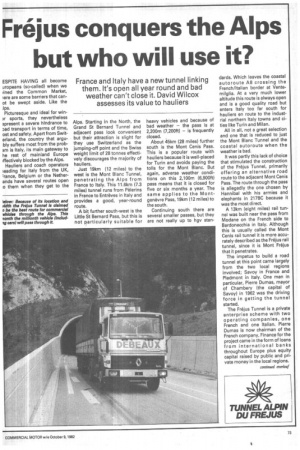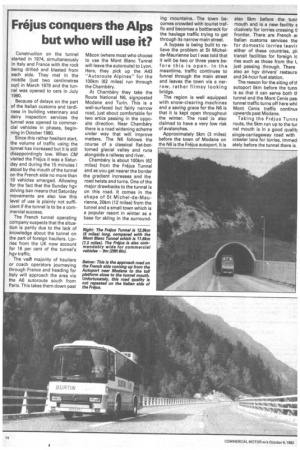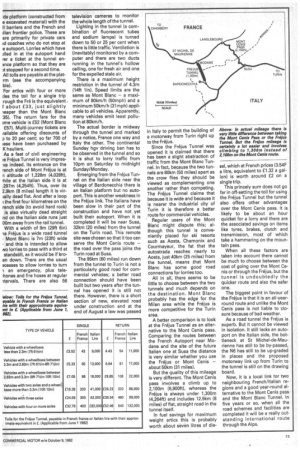Frejus conquers the Alps but who will use it?
Page 57

Page 58

Page 59

If you've noticed an error in this article please click here to report it so we can fix it.
France and Italy have a new tunnel linking them. It's open all year round and bad weather can't close it. David Wilcox assesses its value to hauliers
ESPITE HAVING all become uropeans (so-called) when we ■ ined the Common Market, tere are some barriers that canot be swept aside. Like the Ips.
Picturesque and ideal for winar sports, they nevertheless apresent a severe hindrance to pad transport in terms of time, ost and safety. Apart from Switerland, the country that argubly suffers most from the probam is Italy, its main gateway to he rest of mainland Europe !ffectively blocked by the Alps. Hauliers and coach operators leading for Italy from the UK, :rance, Belgium or the Netherands have several routes open o them when they get to the Alps. Starting in the North, the Grand St Bernard Tunnel and adjacent pass look convenient but their attraction is slight for they use Switzerland as the jumping-off point and the Swiss weight limit of 28 tonnes effectively discourages the majority of hauliers.
Just 19km (12 miles) to the west is the Mont Blanc Tunnel, penetrating the Alps from France to Italy. This 11.6km (7.3 miles) tunnel runs from Pelerins in France to Entreves in Italy and provides a good, year-round route.
A bit further south-west is the Little St Bernard Pass, but this is not particularly suitable for heavy vehicles and because of bad weather — the pass is at 2,200m (7,200ft) — is frequently closed.
About 45km (28 miles) further south is the Mont Cenis Pass. This is a popular route with hauliers because it is well-placed for Turin and avoids paying the tolls for the Mont Blanc. But again, adverse weather conditions on this 2,100m (6,900ft) pass means that it is closed for five or six months a year. The same applies to the Montgenevre Pass, 19km (12 miles) to the south.
Continuing south there are several smaller passes, but they are not really up to hgv stan dards. Which leaves the coastal autoroute A8 crossing the French/Italian border at Ventemilglia. At a very much lower altitude this route is always open and is a good quality road but enters Italy too far south for hauliers en route to the industrial northern Italy towns and cities like Turin and Milan.
All in all, not a great selection and one that is reduced to just the Mont Blanc Tunnel and the coastal autoroute when the weather is bad.
It was partly this lack of choice that stimulated the construction of the Frejus Tunnel, primarily offering an alternative road route to the adjacent Mont Cenis Pass. The route through the pass is allegedly the one chosen by Hannibal with his armies and elephants in 217BC because it was the most direct.
A 13km (eight miles) rail tunnel was built near the pass from Modane on the French side to Bardonecchia in Italy. Although this is usually called the Mont Cenis rail tunnel it is more accurately described as the Frejus rail tunnel, since it is Mont Frejus that it penetrates.
The impetus to build a road tunnel at this point came largely from the two local regions involved; Savoy in France and Piedmont in Italy. One man in particular, Pierre Dumas, mayor of Chambery (the capital of Savoy) in 1962 was the driving force in getting the tunnel started.
The Frejus Tunnel is a private enterprise scheme with two operating companies, one French and one Italian. Pierre Dumas is now chairman of the French company. Finance for the project came in the form of loans from international banks throughout Europe plus equity capital raised by public and private money in the local regions. Construction on the tunnel started in 1974, simultaneously in Italy and France with the rock being drilled and blasted from each side. They met in the middle (just two centimetres out) in March 1979 and the tunnel was opened to cars in July 1980.
Because of delays on the part of the Italian customs and tardiness in building veterinary and dairy inspection services the tunnel was opened to commercial vehicles in phases, beginning in October 1980.
Since this rather hesitant start, the volume of traffic using the tunnel has increased but it is still disappointingly low. When CM visited the Frejus it was a Saturday and during the 15 minutes I stood by the mouth of the tunnel on the French side no more than 10 vehicles emerged. Allowing for the fact that the Sunday hgv driving ban means that Saturday movements are also low this level of use is plainly not sufficient if the tunnel is to be a commercial success.
The French tunnel operating company suspects that the situation is partly due to the lack of knowledge about the tunnel on the part of foreign hauliers. Lorries from the UK now account for 16 per cent of the tunnel's hgv traffic.
The yea majority of hauliers or coach operators journeying through France and heading for Italy will approach the area via the A6 autoroute south from Paris. This takes them down past Macon (where most who choose to use the Mont Blanc Tunnel will leave the autoroute) to Lyon. Here, they pick up the A43 "Autoroute Alpines" for the 100km (62 miles) run through the Chambery.
At Chambery they take the Route National N6, signposted Modane and Turin. This is a well-surfaced but fairly narrow road, just about comfortable for two artics passing in the opposite direction. Near Chambery there is a road widening scheme under way that will improve matters. The N6 follows the course of a classical flat-bottomed glacial valley and runs alongside a railway and river.
Chambery is about 100km (62 miles) from the Frejus Tunnel and as you get nearer the border the gradient increases and the road twists and turns. One of the major drawbacks to the tunnel is on this road. It comes in the shape of St Michel-de-Maurienne, 20km (12 miles) from the tunnel and a small town which is a popular resort in winter as a base for skiing in the surround
ing mountains. The town becomes crowded with tourist traffic and becomes a bottleneck for the haulage traffic trying to get through its narrow main street.
A bypass is being built to relieve the problem at St Michelde-Maurienne but I was told that it will be two or three years before this is open. In the meantime, traffic continues to funnel through the main street and leaves the town via a narrow, rather flimsy looking bridge.
The region is well equipped with snow-clearing machines and a saving grace for the N6 is that it is kept open throughout the winter. The road is also claimed to have a very low risk of avalanches.
Approximately 5km (3 miles) before the town of Modane on the N6 is the Frejus autoport. It is also 5km before the turn' mouth and is a new facility e clusively for lorries crossing tl frontier. There are French al Italian customs services the for domestic lorries leavir either of these countries, pit transit facilities for foreign lc ries such as those from the L just passing through. There also an hgv drivers' restaural and 24-hour fuel station.
The reason for the siting of tlautoport 5km before the tunn is so that it can serve both th tunnel and the Mont Cenis pas: tunnel traffic turns off here whil Mont Cenis traffic continuE upwards past Modane.
Taking the Frejus TunnE route, the 5km run up to the tur nel mouth is in a good qualit) single-carriageway road with crawler lane for lorries. lmmedi ately before the tunnel there is de platform (constructed from e excavated material) with the II barriers and the French and ilian frontier police. These are ere primarily for private cars id coaches who do not stop at e autoport. Lorries which have died in at the autoport hand fer a ticket at the tunnel en3nce platform so that they are A stopped for a second time.
All tolls are payable at the platrm (see the accompanying ble).
For artics with four or more des the toll for a single trip rough the Fre is the equivalent . I about £33, just slightly leaper than the Mont Blanc 35). The return fare for the ime vehicle is £52 (Mont Blanc £57). Multi-journey tickets are reliable offering discounts of to 20 per cent; so far 700 of iese have been purchased by K hauliers.
As a feat of civil engineering le Frejus Tunnel is very impresye indeed. Its entrance on the rench side of Mont Frejus is at r1 altitude of 1,228m (4,028ft), ihile at the Italian side it is at ,297m (4,254ft). Thus, over its 2.9km (8 miles) length it is virrally dead flat. And after a loop the first four kilometres on the rench side (to avoid hard rock) is also virtually dead straight nd on the Italian side runs just 00m away from the rail tunnel. With a width of 9m (29ft 6in) le Frejus is a wide road tunnel Mont Blanc is 7m (23ft) wide and this is intended to allow NO lorries to pass with a third at standstill, as it would be if broen down. There are the usual 3cesses to allow lorries to turn
an emergency, plus telehones and fire hoses at regular Aervals. There are also 56 television cameras to monitor the whole length of the tunnel.
Lighting in the tunnel (a combination of fluorescent tubes and sodium lamps) is turned down to 50 or 25 per cent when there is little traffic. Ventilation is (inevitably) monitored by a computer and there are two ducts running in the tunnel's hollow ceiling, one for fresh air and one for the expelled stale air.
There is a maximum height restriction in the tunnel of 4.3m (14ft 1n). Speed limits are the same as Mont Blanc — a maximum of 80km/h (50mph) and a minimum 50km/h (31mph) applicable to all vehicles. Apparently, many vehicles emit least pollution at 80km/h.
The actual border is midway through the tunnel and marked by a notice, France one way and Italy the other. The continental Sunday hgv driving ban has to be observed in the tunnel and so it is shut to lorry traffic from 10pm on Saturday to midnight Sunday/Monday.
Emerging from the Frejus Tunnel on the Italian side near the village of Bardonecchia there is an Italian platform but no autoport. This is another weakness in the Frejus link. The Italians have been slow in their part of the construction and have not yet built their autoport. When it is completed it will be near Susa, 32km (20 miles) from the tunnel on the Turin road. This remote site was chosen so that it too can serve the Mont Cenis route — the road over the pass joins the Turin road at Susa.
The 95km (60 miles) run down from the tunnel to Turin is not a particularly good road for commercial vehicles; a better road connection should have been built but two years after the tunnel has opened it is still not there. However, there is a short section of new, elevated road under construction and at the end of August a law was passed in Italy to permit the building of a motorway from Turin right up to the Frejus.
Since the Frejus Tunnel was opened it is claimed that there has been a slight abstraction of traffic from the Mont Blanc Tunnel. In fact, because the two tunnels are 80km (50 miles) apart as the crow flies they should be viewed as complementing one another rather than competing. The Frejus Tunnel claims that because it is wide and because it is nearer the industrial city of Turin it is therefore a better route for commercial vehicles.
Regular users of the Mont Blanc might dispute this; although this tunnel is conveniently placed for ski resorts such as Aosta, Chamonix and Courmayeur, the fat that the autostrada reaches nearly to Aosta, just 40km (25 miles) from the tunnel, means that Mont Blanc has some good road connections for lorries too.
All in all, there seems to be little to choose between the two tunnels and much depends on the destination. Mont Blanc probably has the edge for the Milan area while the Frejus is more competitive for the Turin area.
A better comparison is to look at the Frejus Tunnel as an alternative to the Mont Cenis pass. Comparing the routes between the French Autoport near Modane and the site of the future Italian one at Susa the distance is very similar whether you use the Frejus or Mont Cenis — about 50km (31 miles).
But the quality of this mileage is very different. The Mont Cenis pass involves a climb up to 2,100m (6,900ft), whereas the Frejus is always under 1,300m (4,264ft) and includes 12.9km (8 miles) of flat, straight road in the tunnel itself.
In fuel savings for maximum weight artics this is probably worth about seven litres of die sel, which at French prices (3.54F a litre, equivalent to £1.32 a gallon) is worth around £2 on a single trip.
This princely sum does not go far in off-setting the toll for using the Frejus Tunnel but the tunnel also offers other advantages over the Mont Cenis pass. It is likely to be about an hour quicket for a lorry and there are the associated savings on items like tyres, brakes, clutch and transmission, most of which take a hammering on the mountain pass.
When all these factors are taken into account there cannot be much to choose between the
cost of going over the Mont Cenis or through the Frejus, but the
tunnel is undoubtedly the quicker route and also the safer one.
The biggest point in favour of the Frejus is that it is an all-year round route and unlike the Mont Cenis pass is not liable to closure because of bad weather.
As a road tunnel the Frejus is superb. But it cannot be viewed in isolation. It still lacks an auto port on the Italian side, the bottleneck at St Michel-de-Mau rienne has still to be by-passed, the N6 has still to be up-graded in places and the proposed motorway link up from Turin to the tunnel is still on the drawing board.
Now, it is a local link for two neighbouring French/Italian regions and a good year-round alternative to the Mont Cenis pass • and the Mont Blanc Tunnel. In five years or so, when all the road schemes and facilities are completed it will be a really outstanding international route through the Alps.
































































